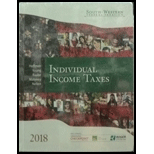
South-western Federal Taxation 2018: Individual Income Taxes
41st Edition
ISBN: 9781337385886
Author: William H. Hoffman, James C. Young, William A. Raabe, David M. Maloney, Annette Nellen
Publisher: Cengage Learning
expand_more
expand_more
format_list_bulleted
Question
Chapter 17, Problem 48P
To determine
State the tax status of the property to the Corporation and the nature of the recognized gain or loss if the corporation sells the property.
Expert Solution & Answer
Want to see the full answer?
Check out a sample textbook solution
Students have asked these similar questions
hello tutor provide solution
help me teacher for this general accounting question
Don't use ai given answer accounting questions
Chapter 17 Solutions
South-western Federal Taxation 2018: Individual Income Taxes
Ch. 17 - Prob. 1DQCh. 17 - Prob. 2DQCh. 17 - Prob. 3DQCh. 17 - Prob. 4DQCh. 17 - Prob. 5DQCh. 17 - A depreciable business dump truck has been owned...Ch. 17 - Prob. 10DQCh. 17 - Prob. 11DQCh. 17 - Prob. 12DQCh. 17 - Prob. 13DQ
Ch. 17 - Prob. 15DQCh. 17 - Prob. 16DQCh. 17 - Prob. 17DQCh. 17 - Prob. 18DQCh. 17 - Prob. 19DQCh. 17 - Prob. 20DQCh. 17 - Prob. 21CECh. 17 - Prob. 22CECh. 17 - Prob. 23CECh. 17 - Prob. 24CECh. 17 - Prob. 25CECh. 17 - Prob. 26CECh. 17 - Prob. 27CECh. 17 - Prob. 28CECh. 17 - Prob. 29CECh. 17 - Prob. 30CECh. 17 - Prob. 31PCh. 17 - Prob. 32PCh. 17 - LO.2 A sculpture that Korliss Kane held for...Ch. 17 - Prob. 34PCh. 17 - Prob. 35PCh. 17 - Prob. 36PCh. 17 - Prob. 37PCh. 17 - Prob. 38PCh. 17 - Prob. 39PCh. 17 - Prob. 40PCh. 17 - Prob. 41PCh. 17 - Prob. 43PCh. 17 - Joanne is in the 24% tax bracket and owns...Ch. 17 - Prob. 45PCh. 17 - Prob. 46PCh. 17 - Prob. 47PCh. 17 - Prob. 48PCh. 17 - Prob. 49PCh. 17 - Prob. 50PCh. 17 - Prob. 51PCh. 17 - Prob. 52PCh. 17 - Prob. 53PCh. 17 - Prob. 54PCh. 17 - Jay sold three items of business equipment for a...Ch. 17 - Prob. 1RPCh. 17 - Prob. 2RPCh. 17 - Prob. 3RPCh. 17 - Prob. 4RPCh. 17 - Prob. 1CPACh. 17 - Prob. 2CPACh. 17 - Jerry uses a building for business purposes. The...Ch. 17 - Prob. 4CPACh. 17 - Prob. 5CPACh. 17 - Prob. 6CPACh. 17 - Wally, Inc., sold the following three personal...Ch. 17 - Net Section 1231 losses are: a. Deducted as a...Ch. 17 - Prob. 9CPACh. 17 - Prob. 10CPA
Knowledge Booster
Similar questions
- Zanzibar Limited entered into a lease agreement on July 1 2016 to lease some highly customized hydraulic equipment to Kaizen Limited. The fair value of the equipment as at that date was $ 700,000. The terms of the lease agreement were:Lease term5 yearsEquipment economic life6 yearsAnnual rental payment, in arrears (commencing June 30th 2017)$160,000Equipment residual value$100,000Guaranteed residual value by Zanzibar$60,000Incremental borrowing rate8%Interest rate implicit in the lease6%Note: the lease is cancellable but only with Zanzibar’s permissionAt the end of the lease term, the equipment is to be returned to Zanzibar Limited. On July 1, 2016, Zanzibar incurred $12,000 in legal fees for setting up the lease. The annual rental payment includes $10, 000 to reimburse the lessor for maintenance fees incurred on behalf of the lessee.Requirements:a)Discuss the nature of the lease using the appropriate criteria. Justify your answer using calculations where applicableb)Prepare the lease…arrow_forwardplease get correct answerarrow_forwardneed help with this General accounting questionarrow_forward
arrow_back_ios
SEE MORE QUESTIONS
arrow_forward_ios
Recommended textbooks for you
 Individual Income TaxesAccountingISBN:9780357109731Author:HoffmanPublisher:CENGAGE LEARNING - CONSIGNMENT
Individual Income TaxesAccountingISBN:9780357109731Author:HoffmanPublisher:CENGAGE LEARNING - CONSIGNMENT



Individual Income Taxes
Accounting
ISBN:9780357109731
Author:Hoffman
Publisher:CENGAGE LEARNING - CONSIGNMENT


